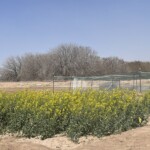 By Girisha Ganjegunte, Ph.D.
By Girisha Ganjegunte, Ph.D.
A multi-disciplinary (agronomy, soil science, plant physiology, engineering, and economics), multi-institutional and multi-location study is underway to evaluate the potential to adapt and increase acreage of canola in southern New Mexico and far west Texas using alternative irrigation water sources. This goal directly aligns with the National Institute of Food and Agriculture’s Supplemental and Alternative Crops competitive grants program, namely expanded adaptation and increased acreage of U.S. of canola. Texas A&M University received funding through this program to: 1) Identify salt-tolerant cultivars of canola; 2) evaluate performance (physiological response and yield) of salt-tolerant canola cultivar(s) irrigated with marginal quality water irrigation; 3) determine changes to soil properties, including salinity, to develop appropriate and best management practices; and (4) evaluate the economic feasibility of producing winter canola with marginal water.
 Identifying Salt-Tolerant Cultivars
Identifying Salt-Tolerant Cultivars
Twenty-four (23) canola genotypes were evaluated for salinity tolerance during emergence and at seedling stage in a growth chamber and greenhouse at Bushland, Texas during spring seasons of 2022 and 2023. Results indicated that among the winter canola cultivars, ‘Athena’, ‘CP225WRR’ and ‘Ericka’ are top performers with greater leaf area and biomass production, indicating they are more tolerant to salinity than other cultivars. Among the spring cultivars across various salinity levels, ‘CP9978TF’, ‘Gem’ and ‘PI601200’ had greater leaf area, while ‘CP930RR’, ‘CP9978TF’ and ‘PI97352’ had greater biomass.
 Evaluating Cultivar Performance
Evaluating Cultivar Performance
During the fall of 2021, three winter canola cultivars (‘CP322WRR’, ‘CP220WR’, ‘CP115W’) and in the spring of 2023, three spring canola cultivars (CP930RR, CP955RR, and CP9978TF) were simultaneously evaluated in both El Paso, Texas, and Artesia, New Mexico. Since these study sites were abandoned cotton fields, plots were fertilized with adequate amounts of nitrogen, P2O5 and K2O (120 lbs/acre) and irrigated with equal amounts of about 24 inches of fresh and waste waters to their respective plots. Weed control was achieved with Roundup® herbicide. Among the three winter varieties, ‘CP320WRR’ performed better than the other two with an average seed yield of 1,650 lbs/acre. All three spring cultivars performed better than winter varieties planted during the previous fall with ‘CP930RR’ producing the highest yield (2,576 lbs/acre). There were no significant differences in yield levels between wastewater and freshwater irrigated plots, indicating salinity tolerance of canola and irrigation potential with saline wastewater.
Drone aerial imaging was performed over the canola experimental field plots in El Paso during spring seasons of 2022 and 2023. Data from four imagers were collected during each flight to detect changes and anomalies in canola response under different treatments. At the same time, canola leaf samples were collected from all experimental field plots and scanned in the lab under halogen lights. Preliminary results indicated clear differences between canola irrigated with freshwater versus saline-treated urban wastewater, indicating the utility of imaging as early warning of stress.
 Determining Changes to Soil Properties
Determining Changes to Soil Properties
Baseline as well as end-of-season soil samples at El Paso and Artesia study sites were collected from root-zone depths (0-15 cm, 15-30 cm, 30-45 cm, 45-60 cm and 60-100 cm), processed and analyzed for specific properties, including salinity, to evaluate effects of saline water irrigation. Results indicated that irrigation with wastewater did not have any significant effects on pH or salinity. However, there was a significant increase in the root zone sodium adsorption ratio but the levels were below the threshold value, indicating no impairment in soil permeability.
 Evaluating Economic Feasibility
Evaluating Economic Feasibility
Investigators are keeping track of quantities and costs of various inputs used in the field study. The team economist of is also keeping track of canola’s market outlook. This data will be used to develop an enterprise budget and conduct benefit cost analysis.
Girisha Ganjegunte, Ph.D., is professor of water resources and salinity management in the Department of Soil and Crop Sciences at Texas A&M University’s AgriLife Research Center in El Paso, Texas.